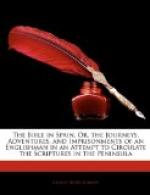Oviedo contains about fifteen thousand inhabitants. It is picturesquely situated between two mountains, Morcin and Naranco; the former is very high and rugged, and during the greater part of the year is covered with snow; the sides of the latter are cultivated and planted with vines. The principal ornament of the town is the cathedral, the tower of which is exceedingly lofty, and is perhaps one of the purest specimens of Gothic architecture at present in existence. The interior of the cathedral is neat and appropriate, but simple and unadorned. I observed but one picture, the Conversion of Saint Paul. One of the chapels is a cemetery, in which rest the bones of eleven Gothic kings; to whose souls be peace.
I bore a letter of recommendation from Coruna to a merchant of Oviedo. This person received me very courteously, and generally devoted some portion of every day to showing me the remarkable things of Oviedo.
One morning he thus addressed me: “You have doubtless heard of Feijoo, the celebrated philosophic monk of the order of Saint Benedict, whose writings have so much tended to remove the popular fallacies and superstitions so long cherished in Spain; he is buried in one of our convents, where he passed a considerable portion of his life. Come with me and I will show you his portrait. Carlos Tercero, our great king, sent his own painter from Madrid to execute it. It is now in the possession of a friend of mine, Don Ramon Valdez, an advocate.”
Thereupon he led me to the house of Don Ramon Valdez, who very politely exhibited the portrait of Feijoo. It was circular in shape, about a foot in diameter, and was surrounded by a little brass frame, something like the rim of a barber’s basin. The countenance was large and massive but fine, the eyebrows knit, the eyes sharp and penetrating, nose aquiline. On the head was a silken skull-cap; the collar of the coat or vest was just perceptible. The painting was decidedly good, and struck me as being one of the very best specimens of modern Spanish art which I had hitherto seen.
A day or two after this I said to Benedict Mol, “to-morrow I start from hence for Santander. It is therefore high time that you decide upon some course, whether to return to Madrid or to make the best of your way to France, and from thence proceed to your own country.”
“Lieber herr,” said Benedict, “I will follow you to Santander by short journeys, for I am unable to make long ones amongst these hills; and when I am there, peradventure I may find some means of passing into France. It is a great comfort, in my horrible journeys, to think that I am travelling over the ground which yourself have trodden, and to hope that I am proceeding to rejoin you once more. This hope kept me alive in the bellotas, and without it I should never have reached Oviedo. I will quit Spain as soon as possible, and betake me to Lucerne, though it is a hard thing to leave the schatz behind me in the land of the Gallegans.”




